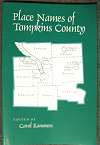- By Dan Veaner
- Around Town
 Print
Print  Last week Lansing Town Historian Louise Bement announced that a new brochure has been published to promote the town and many of its important landmarks. The brochure is part of the second project taken on by Tompkins County historians led by County Historian Carol Kammen. The result is nine county community brochures with maps that can be used for driving tours of historical sites, lodging, shopping, cemeteries, and recreational areas for each town. "Every town historian is distributing them," Bement says. "I took mine to the Federal House, to every hotel, the churches, any place that's mentioned in the brochure. The Town Halls have them, and they're all down at the Chamber of Commerce Visitor's Center."
Last week Lansing Town Historian Louise Bement announced that a new brochure has been published to promote the town and many of its important landmarks. The brochure is part of the second project taken on by Tompkins County historians led by County Historian Carol Kammen. The result is nine county community brochures with maps that can be used for driving tours of historical sites, lodging, shopping, cemeteries, and recreational areas for each town. "Every town historian is distributing them," Bement says. "I took mine to the Federal House, to every hotel, the churches, any place that's mentioned in the brochure. The Town Halls have them, and they're all down at the Chamber of Commerce Visitor's Center."Nine communities within the county have official historians that Kammen has organized them to meet monthly to share their towns' rich history. The first project produced by the group is the book, 'Place Names of Tompkins County,' in which each local historian wrote a chapter chronicling the evolution of place names in their town or village. Most Lansing residents know where Rogue's harbor is, but do you know where Esty's is in Lansing? Or that it was originally known as Forest City? Or that Lansing itself was named for a Supreme Court judge?

Click to see in PDF format

On occasion Town officials have suggested that a driving tour of Lansing sites could be a way for the town to participate in tourist initiatives such as the Cayuga Wine trail. At one point the Town was considering a location on Salmon Creek Road for the historical North log cabin, which would join points of interest that include Ludlowville, the Field one room schoolhouse, and other sights in the town. If and when the Town does take on that project Bement says she is ready. "I have the tour all mapped out," she says. "Because my first draft was just that."
Bement's office is located in the new Lansing Historical Records building, a wooden structure in the square by the Town Hall. All of the Town historical records, originally stored at various locations around Lansing, have been moved to the new building, while official town records are archived on the second level.

Originally the group planned to print the brochures last April, so the deadline for getting attractions listed was last January. Whenever you list attractions some are bound to be left out. And attractions that ended up in the final draft were not necessarily what historians originally intended. "It was a group decision," Bement says. "We had to come to compromises on what would work for everybody so that they all would look similar. Originally I had a lot of restaurants in it. But some of the towns didn't have very many restaurants, and the ones they had were Pizza Huts. Finally we decided we wouldn't include restaurants at all, so I lost all that information."
The local historians meet almost every month at the conference room at the Tompkins County Solid Waste Center. Bement says there are nine historians, and some communities have deputy historians who attend, as well as some people who just come because they are interested. Some meetings include speakers, while others are used to exchange historical information among the participants. Bement says that while the historians don't plan to update the brochures, each town will get a disk with the files needed so they can update them if they so choose.
Meanwhile the group is anticipating work on a new project. "We're going to take digital pictures of every church in our towns that are still standing," Bement says. "We'll write about when it began, how long it was in service, and things like that. That will go on a Web site that we hope to have."
Click here for a brief overview of Lansing
----
v3i41



